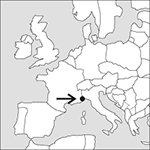
Source: MAPS IN MINUTES™ © RH Publications (1997)
Capital:
Monaco
Area:
2 sq km (1 sq miles)
Population:
30,500 (2013 est)
Currency:
1 euro=100 cents
Religions:
Roman Catholic 90.0%
Ethnic Groups:
French 47.0%; Monégasque 16.0%; Italian 16.0%
Languages:
French (official); English; Italian; Monégasque
International Organizations:
UN; OSCE; Council of Europe
A small principality located in the south of France in the hills above the Mediterranean Sea.
Physical
The ancient town and its fortress perch on a rocky outcrop that projects into the Mediterranean Sea. On this part of the Riviera, steep, white limestone cliffs, representing the incipient Alps, stand out along the coastline with sheltered intervening bays. The numerous caves and grottoes were long occupied by Palaeolithic peoples.
Economy
Tourism and banking are Monaco’s major industries. Gambling is a major attraction; the casino (built in 1861) has been state-run since 1967. Low personal and business taxes have made Monaco a tax haven. Mineral resources are lacking, and there is no agriculture.
History
Monaco was held by the Genoese from 1191 until 1297, when it passed to the Grimaldi family. The Grimaldis were allies of France, except for a period of allegiance to Spain (1524–1641), but Monaco was annexed by France in 1793 under the French Revolutionary Regime. The Congress of Vienna returned the principality to the Grimaldis but placed it under the protection of Sardinia. In 1861 France restored Monaco’s independence. Monaco adopted its first constitution in 1911, formalizing its status as a hereditary principality. A more democratic constitution was adopted in 1962, but the monarchy was retained. Prince Rainier III came to the throne in 1949 and was succeeded by his son, Prince Albert II, on his death in 2005. In 1993 Monaco joined the United Nations.
- heuristics
- heuristic search
- Heusler alloys
- Hevelius, Johannes
- Hevelius, Johannes (1611–87)
- Hevesy, George Charles von
- Hewish, Antony
- Hewish, Antony (1924–2021)
- Hewlett-Packard
- hex
- hexachlorobenzene
- Hexacorallia
- Hexactinellida
- hexacyanoferrate(II)
- hexacyanoferrate(III)
- hexad
- SFOF
- S-fold
- Sforza
- SG
- S-gate
- SGCS
- SGML
- sgn
- SH2 domain